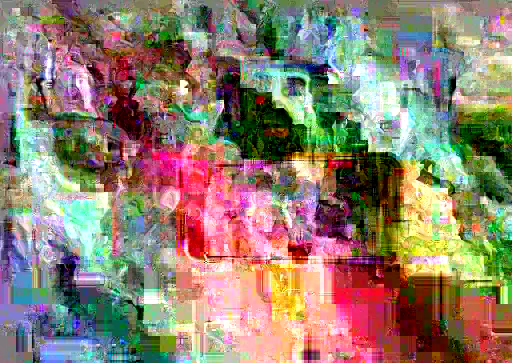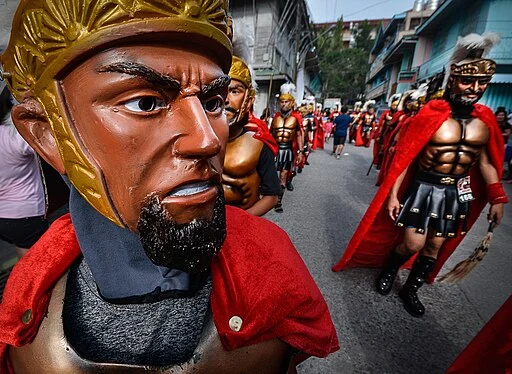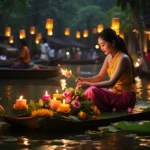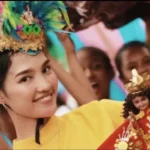Image Source: EMMAN A. FORONDA, CC BY-SA 4.0, via Wikimedia Commons
The Moriones Festival in Marinduque in the Philippines is a unique and colorful celebration, known for its elaborate masks and costumes, some featuring a one-eye design. Get ready to be transported to a time of legends and folklore as you witness the vivid and colorful reenactment of Longinus’ capture in the Moriones tradition telling the story of Longinus, the Roman centurion with a blind eye.
Held annually during Holy Week, the Marinduque’s Moriones festival has become an event that brings together the lively people of Marinduque and tourists alike in a vibrant spurt of festivities around the town.
With its rich history, fascinating Moriones traditions, stunning landscapes, and people’s penitent devotion draped in capes as an atonement for their sins during Easter Sunday, Situated in the heart of the Philippines, Marinduque is a destination that enchants everyone.
Key Takeaways
- The vibrant and colorful Moriones Festival is an annual religious event that takes place during Holy Week in Marinduque.
- The festival held annually during Holy Week reenacts the story of Longinus, the Roman centurion with one blind eye, and his conversion to Christianity.
- The vivid Moriones Festival showcases Marinduque’s cultural heritage, and the people’s religious devotion, a spectacle of atonement for their sins on Easter Sunday, thus attracting tourists from all over.
- The festival celebrates the ethnic diversity of Marinduque and displays Moriones festival costumes with various ethnic groups participating and showcasing their unique cultural practices.
Facts About The Moriones Festival Philippines
| Facts | Explanation |
|---|---|
| Name of the festival: | Moriones Festival |
| Type of festival: | Religious and cultural festival |
| Festival Etymology: | The festival’s name is derived from “morion,” which means “mask” or “visor” in Spanish. |
| Date celebrated first: | April 1, 1807 |
| Founder of the Festival: | No specific founder – The Moriones Festival originated from the Spanish colonial period and was introduced by the friars as a way to depict the story of Longinus, the Roman centurion who pierced Jesus’ side with a spear. |
| Brief history of the festival: | The Moriones Festival is a reenactment of the story of Longinus and his conversion to Christianity after witnessing the events surrounding Christ’s crucifixion. Participants, known as “Moriones,” wear colorful masks (morions) and Roman-inspired costumes. They roam the streets of Marinduque, engaging in theatrical performances and reenactments. The festival has evolved to become a significant cultural and religious event in the Philippines. |
| Brief history of the city: | The Moriones Festival takes place in the city of Marinduque, which is known as the “Heart of the Philippines.” Marinduque has a rich history dating back to pre-colonial times, with influences from Malay, Chinese, and Spanish cultures. It has played a crucial role in shaping Filipino history and is known for its natural beauty and pristine beaches. |
| Ethnic information: | Majority Tagalog, with Visayan and other indigenous groups |
| Location of the city within the country: | Marinduque is an island province located in the MIMAROPA region of the Philippines. |
| How to reach the city: | By air: Fly to Manila, then take a domestic flight to Marinduque Airport. By sea: Take a ferry from Lucena Port in Quezon Province to Balanacan Port in Marinduque. |
| Nearby cities or towns and their distance: | The majority Tagalog, with Visayan and other indigenous groups |
| Google map link to the city location: | Marinduque |
| Festival main events and activities: | – Moriones Parade – Passion Play reenactments – Mask-making contests – Street performances – Processions – Cultural shows |
| Other famous tourist attractions in the city: | – Poctoy White Beach – Mt. Malindig – Bathala Caves – Tres Reyes Islands – Bellarocca Island Resort and Spa |
| Famous food dishes of the city: | – Pancit Marinduque (local noodle dish) – Suman sa Lihiya (sticky rice cake) – Tamales (steamed rice cakes) |
| Landmarks in the city: | – Boac Cathedral (Cathedral of the Immaculate Conception) – Palad Sandbar – Moriones Arena – Malbog Sulfur Spring |
| Related festivals in the same region: | – Pahiyas Festival (Lucban, Quezon) – Ati-Atihan Festival (Kalibo, Aklan) – Panagbenga Festival (Baguio City, Benguet) |
Brief History of Moriones Festival in the Philippines: What Is Moriones Festival
The Moriones Festival is a religious event celebrated particularly in the province of Marinduque. It is held during Holy Week, which falls in April. The festival has its roots in Spanish colonial times and has become one of the most popular and vibrant festivals in the country.
The origins of the Moriones Festival can be traced back to the 1800s when Spain ruled over the Philippines. The word “moriones” refers to the Roman soldiers who wore masks and helmets during the time of Jesus Christ. These soldiers were known for their cruelty and were responsible for the crucifixion of Jesus.
According to local folklore, a Roman centurion named Longinus, who was partially blind, witnessed the death of Jesus on the cross. He was miraculously healed by a drop of Jesus’ blood that landed on his eyes. Longinus became a convert to Christianity and eventually suffered martyrdom for his faith.
The Moriones Festival reenacts this story through various activities and events. Participants wear colorful costumes and masks resembling Roman soldiers. They parade through the streets, reenacting the capture, trial, and crucifixion of Jesus. The festival culminates in a grand procession on Good Friday, where the centurions seek redemption for their sins.

Apart from the religious aspect, the Moriones Festival also serves as a tourist attraction in Marinduque. Visitors from all over the country and even abroad come to witness the lively and dramatic performances. The festival not only showcases religious devotion but also promotes the cultural heritage of the province.
Over the years, the Moriones Festival has evolved and grown, attracting more participants and spectators. It has become an integral part of Filipino culture, symbolizing faith, passion, and devotion during the Lenten season.
Ethnic Information
You’ll find a variety of ethnic groups participating in the Moriones Festival in the Philippines. The festival takes place in the province of Marinduque and attracts locals and tourists alike.
Marinduque is known for its rich cultural heritage and diverse population. During the Moriones Festival, you can witness the vibrant traditions and customs of different ethnic groups, such as the Tagalogs, Bicolanos, and Visayans.
These groups showcase their unique cultural practices through colorful costumes, music, and dance performances. The festival provides a platform for these ethnic communities to come together and celebrate their shared heritage.
It is a wonderful opportunity to experience the rich cultural tapestry of the Philippines and gain a deeper understanding of the country’s ethnic diversity.
Festival Etymology

The word “Moriones” is derived from the Spanish word “morion,” which refers to a kind of helmet worn by Roman soldiers during the time of Christ.
The festival is named after the helmet, as it symbolizes the story of Longinus, a Roman centurion who converted to Christianity after piercing the side of Jesus with a spear during the crucifixion.
The festival features men and women wearing colorful costumes and masks resembling Roman soldiers, reenacting the events of the Passion of Christ. It is a unique celebration that combines religious devotion and cultural heritage.
Brief History Of The City
Marinduque is an island province located in the Philippines. It has a vibrant history that dates back to ancient times. The name “Marinduque” is believed to have originated from the Tagalog word “Malindik” which means “to fly.”
During the pre-colonial period, Marinduque was known as “Mait,” which was a trading center for Chinese, Muslim, and Southeast Asian merchants. The island was also inhabited by an indigenous tribe called Mangyans.
In 1570, the Spanish conquistadors arrived in Marinduque and established their presence in the area. They built churches and introduced Christianity to the locals. Marinduque became part of the Spanish colonial administration and remained under Spanish rule for centuries.
Throughout its history, Marinduque played a significant role in the Philippine Revolution against Spanish colonization. In 1901, during the Philippine-American War, Marinduque became a separate province from Tayabas (now Quezon) and was officially recognized as a province of the Philippines.
Marinduque has also been known for its colorful festivals, such as the Moriones Festival. This annual event showcases traditional religious practices and reenacts the story of Longinus, a Roman centurion who converted to Christianity after witnessing the crucifixion of Jesus Christ.
Today, Marinduque is not only known for its historical significance but also its natural beauty. The province is home to stunning beaches, crystal-clear waters, and diverse marine life, making it a popular destination for tourists and nature lovers alike.
Location of the City in the country
Marinduque, the city where the Moriones Festival takes place, is located in the Mimaropa Region of the Philippines.
This quaint city is known for its vibrant celebration of the Holy Week, particularly the Moriones Festival. If you’re wondering where exactly Marinduque is situated, take a look at the table below:
| Location | Region |
|---|---|
| Marinduque | Mimaropa |
Marinduque, with its picturesque landscapes and rich cultural heritage, attracts visitors from all over the world during the Holy Week celebration.
The Moriones Festival, one of the most anticipated events in Marinduque, showcases the stunning and intricately designed Moriones costumes. These costumes, worn by the participants, depict the biblical Roman soldiers during the time of Christ.
The festival not only offers a glimpse into the religious traditions but also provides a unique cultural experience. So, if you’re planning to witness the Moriones Festival and immerse yourself in the enchanting beauty of Marinduque, make sure to mark your calendars for the Holy Week celebration.
How to Reach The City
If you’re planning to attend the Moriones Festival in Marinduque, getting to the city is relatively straightforward. Here are some ways to reach the city and join in on the festivities:
- By air: The nearest airport is in Manila. From there, you can take a domestic flight to Marinduque Airport in Gasan town.
- By land and sea: You can also take a bus or drive to Lucena City, then board a ferry to Marinduque Island.
- By sea: Another option is to take a ferry from Batangas Port to Balanacan Port in Marinduque.
- By private vehicle: If you prefer driving, you can take the South Luzon Expressway and Southern Tagalog Arterial Road to reach Marinduque.
- By public transportation: There are buses and vans available from Manila and other nearby provinces that travel to Marinduque.
To help you plan your journey, here’s a table with estimated travel times from different starting points:
| Starting Point | Estimated Travel Time |
|---|---|
| Manila | 4-5 hours |
| Lucena City | 3-4 hours |
| Batangas Port | 2-3 hours |
| Quezon Province | 4-6 hours |
| Laguna Province | 3-4 hours |
Whichever mode of transportation you choose, make sure to check the schedules and plan your trip accordingly. Enjoy the Moriones Festival and have a great time in Marinduque!
Nearby Cities or Towns
Here are some nearby cities or towns of Marinduque, Philippines along with their approximate distance:
- Lucena City, Quezon: Approximately 45 kilometers away from Marinduque.
- Batangas City, Batangas: Approximately 60 kilometers away from Marinduque.
- Lipa City, Batangas: Approximately 75 kilometers away from Marinduque.
- Calapan City, Oriental Mindoro: Approximately 80 kilometers away from Marinduque.
- Santa Cruz, Laguna: Approximately 90 kilometers away from Marinduque.
Please note that the distances mentioned are approximate and may vary depending on the specific locations within Marinduque and the nearby cities or towns.
| City/Town | Distance (km) |
|---|---|
| Boac | 0 |
| Santa Cruz | 14 |
| Mogpog | 16 |
| Torrijos | 19 |
| Gasan | 22 |
| Buenavista | 25 |
| Sta. Fe | 26 |
| Buenavista | 30 |
| Hinundayan | 39 |
| San Juan | 45 |
Please note that distances may vary depending on the route taken.
Moriones Festival Main Events And Activities
Here are some of the main events and activities that take place during the Moriones Festival:
- Moriones Play: One of the highlights of the festival is the Moriones Play, a religious reenactment of the story of Longinus, a Roman centurion who converted to Christianity after witnessing the crucifixion of Jesus Christ. Participants wear colorful masks and costumes as they portray different characters from the biblical story.
- Processions: There are several processions throughout the festival. The most notable one is the “Via Crucis” or “Way of the Cross,” where participants reenact Christ’s journey to Calvary. They carry crosses and walk along the streets while chanting prayers.
- Street Dancing: Colorful street dancing performances are a major part of the Moriones Festival. Dancers wear elaborate costumes and masks, representing different characters from the biblical story. They perform traditional dances and showcase their skills while parading through the streets.
- Parades: The festival features grand parades showcasing beautifully decorated floats and carriages. These parades are filled with music, dance, and vibrant displays, attracting both locals and tourists.
- Beauty Pageants: Beauty pageants are held during the festival to select the “Reyna Elena” or “Queen Helena.” Contestants compete in various categories, including traditional costume, talent, and personality.
- Trade Fairs: Trade fairs are set up during the festival, offering a wide range of local products and crafts. Visitors can purchase souvenirs, handicrafts, and traditional food items.
- Cultural Performances: Various cultural performances, such as folk dances, music concerts, and theater shows, are organized throughout the festival. These performances showcase the rich cultural heritage of Marinduque.
These are just some of the main events and activities that you can experience during the Moriones Festival. The festival is a unique blend of religious devotion, cultural traditions, and vibrant celebrations, making it a must-visit event in the Philippines.
Popular Food Dishes of The City
Explore the wide array of popular food dishes available in the city during the Moriones Festival, where you can indulge in a culinary adventure like no other. Treat your taste buds to the following mouthwatering delights:
- Sizzling Sisig: A sizzling plate of chopped pig’s face and ears marinated in a tangy sauce, topped with a sunny-side-up egg.
- Lechon: A whole roasted pig, crispy on the outside and succulent on the inside, served with a side of liver sauce.
- Pancit Malabon: A flavorful noodle dish loaded with shrimp, squid, and smoked fish, and topped with crushed chicharon.
- Halo-Halo: A refreshing dessert made with crushed ice, sweet beans, fruits, and jellies, and topped with leche flan and ube ice cream.
- Bibingka: A traditional rice cake cooked in clay pots, topped with butter, salted egg, and grated coconut.
Satisfy your cravings and immerse yourself in the culinary delights of the Moriones Festival. Don’t miss out on these delicious treats!
| Dish | Description | Price |
|---|---|---|
| Sizzling Sisig | Chopped pig’s face and ears marinated in a tangy sauce, topped with an egg. | PHP 150 |
| Lechon | Whole roasted pig, crispy on the outside and succulent on the inside. | PHP 300 |
| Pancit Malabon | Flavorful noodle dish loaded with shrimp, squid, smoked fish, and chicharon. | PHP 200 |
Famous Tourist Spots in the City
Discover the captivating allure of the city’s famous tourist spots during the Moriones Festival. Immerse yourself in the rich history and vibrant culture as you explore these must-visit destinations:
- Bataan National Park: Experience the beauty of nature and enjoy activities like hiking and camping.
- Mount Samat National Shrine: Pay homage to the heroes of World War II and admire the breathtaking view from the top.
- Las Casas Filipinas de Acuzar: Step back in time as you wander through this heritage resort showcasing Spanish colonial architecture.
- Pawikan Conservation Center: Learn about the conservation efforts for endangered sea turtles and witness their release into the wild.
- Plaza Mayor de Ciudad de Balanga: Take a stroll around this picturesque plaza, surrounded by historical buildings.
Immerse yourself in the charm and history of these famous tourist spots during the Moriones Festival, and create lasting memories of your visit to the Philippines.
| Tourist Spot | Description | Location |
|---|---|---|
| Bataan National Park | A natural oasis offering stunning landscapes and outdoor activities. | Bataan |
| Mount Samat National Shrine | A memorial site with a towering cross, offering panoramic views of the surrounding area. | Pilar, Bataan |
| Las Casas Filipinas de Acuzar | A unique resort that showcases the architectural heritage of the Philippines. | Bagac, Bataan |
| Pawikan Conservation Center | A sanctuary dedicated to the conservation of sea turtles, where you can witness their release into the wild. | Morong, Bataan |
Each location offers a unique experience, whether it’s exploring nature, delving into history, or immersing yourself in the cultural heritage of the Philippines. So pack your bags and get ready for an unforgettable adventure.
Related Festivals In The Same Region
During your exploration of the captivating allure of the city’s famous tourist spots during the Moriones Festival, you will also have the opportunity to experience several related festivals in the same region.
These festivals showcase the rich cultural heritage and traditions of the Philippines. One of these festivals is the Pahiyas Festival in Lucban, Quezon. Celebrated every May 15th, it is a colorful and vibrant event where houses are adorned with colorful rice decorations.
Another festival is the Panagbenga Festival in Baguio City, known as the “Flower Festival.” This month-long celebration features grand floats adorned with flowers, street dancing, and various events highlighting the city’s blooming flora.
Lastly, there’s the Kadayawan Festival in Davao City, which honors the city’s bountiful harvest and showcases the indigenous cultures of the region. These festivals offer a unique opportunity to immerse yourself in the rich cultural tapestry of the Philippines.
Summary Of Moriones Festival
| Category | Facts | Links |
|---|---|---|
| Festival Name | Moriones Festival | Moriones Festival |
| Location | Island of Marinduque, Philippines | Marinduque |
| Date | Holy Week, usually in March and/or April | – |
| Historical Facts | – The festival is held during Holy Week and is movable based on the timing of the Jewish Passover. – The festival is listed as one of the intangible cultural properties in the Philippines. – The tradition of pugutan (beheading) started in the 1870s by Fr. Dionisio Santiago. – Morion mask refers to both the mask costume and the participant wearing it. – The festival commemorates the suffering, crucifixion, death, and resurrection of Jesus and also incorporates the story of Longinus, the Roman centurion who pierced Christ on the cross. – Moriones Festival became more popular in the 1960s and 1970s with government promotion. | Intangible Cultural Heritage |
| Festival Activities | – Harana ng Morion: Morions go around town singing and playing kalutang instruments for spare coins or cash. – Pasyon: Devotees listen to the reading of Pasyon, a narrative of Jesus’ suffering, death, and resurrection. – Senakulo: A three-night dramatization based on Pasyon. – Pugotan: A reenactment of Longinus’ role in wounding Jesus on the cross. – Salubong: A commemoration of Jesus’ resurrection. – Traditional Putong: A song and dance ritual to welcome guests. – Via Crucis: A street procession and dramatization of the Stations of the Cross. | Pasyon, Senakulo, Via Crucis |
| Organizer | Provincial Tourism Office Province of Marinduque | Marinduque Tourism |
Note: Some links are not available as they are not mentioned in the provided text.
Final Thoughts
Immerse yourself in the captivating cultural tapestry of the Moriones Festival Philippines and reflect on the unforgettable experiences you’ve had.
The Moriones Festival is a celebration that showcases the rich religious heritage and colorful traditions of the Philippines. From the vibrant processions to the elaborate costumes, this festival truly transports you to a different time and place.
As you witness the reenactment of the story of Longinus, the Roman soldier who pierced Jesus’ side, you can’t help but be moved by the fervent devotion and deep faith of the participants. The Moriones Festival is not just a spectacle, but a profound spiritual experience that leaves a lasting impression.
So, as you bid farewell to this incredible event, your final thoughts will undoubtedly be filled with gratitude for the opportunity to witness the beauty and significance of the Moriones Festival firsthand.



